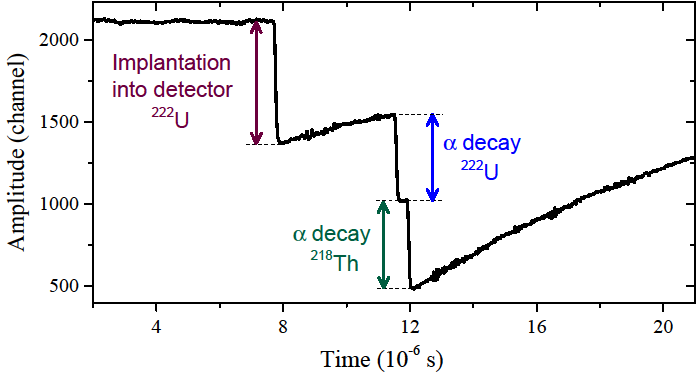An international team of scientists has succeeded to create and detect extremely short-lived atomic nuclei of the element uranium. Having far fewer neutrons than the kind of uranium nuclei found in nature, they exist only for about a millionth of a second. The new data provide key information on how the numbers of neutrons and protons inside exotic heavy nuclei influence their stability. This is important to give better guidance for experiments on the search for new superheavy elements.
In atomic nuclei, protons and neutrons arrange in individual shells. Nuclei containing just the right numbers to fill a proton and a neutron shell are considerably more stable than their neighbours. For protons, 82 is the last known of these “magic numbers”, while it is 126 for neutrons. This makes lead-208, with 82 protons and 126 neutrons, the heaviest “doubly-magic nucleus” known to date. Lead-208 is the main ingredient in lead as used in daily life like in car batteries. For decades, scientists tried finding out how many protons will fit into the next shell, which was conjectured to give rise to an "island of stability" in the region of superheavy elements. Current theoretical models still disagree: some favor 114, others prefer 120 or even 126. Element 114 is known, but can be studied at rates of only about one atom per day. Elements 120 and 126 are yet unknown. Scientists thus look for other experimental data allowing to refine their models.
In their recent work, an international team led by Dr. Jadambaa Khuyagbaatar from the Helmholtz Institute Mainz, Germany, and the GSI Helmholtzzentrum für Schwerionenforschung in Darmstadt, Germany, traced this last neutron shell closure towards heavier elements. The question is whether the neutron number 126 remains as dominant in these increasingly unstable nuclei as it is known to be in lead-208. For this, they produced nuclei uranium, with extra ten protons when compared to lead. Usual uranium nuclei as found in nature, like uranium-238, have far more neutrons than around 126, so the researchers first produced the new uranium-221 and acquired new and improved data on uranium-222, of which only three atoms were observed in a study dating back to 1983.
For this, an intense beam of titanium-50 ions (element 22) was accelerated at GSI Darmstadt and used to irradiate a foil containing ytterbium-176 (element 70). Fusion led to uranium nuclei (element 92), which were separated in the gas-filled recoil separator TASCA and guided to a detector suitable to register their decay. In this way, the team studied these nuclei's instability and found them to decay within microseconds. Such short lifetimes could only be registered thanks to a new, advanced data acquisition system and data analysis techniques. The study of combined data of isotopes of elements from lead up to uranium at and above the 126 neutron shell suggests this to no longer be a pronounced magic neutron number in uranium. These data allow benchmarking models that, e.g., guide efforts to search for new superheavy elements.
The work was published on (date….. 2015) in the scientific journal The Physical Review Letters (J. Khuyagbaatar et al., Phys. Rev. Lett. XX (2015) YYYYYY) and is highlighted here.

The figure shows one of eighty-one registered traces of a triple-signal associated with the implantation of uranium-222 into the detector (red), its emission of an α particle with 9.31 MeV energy (blue) leading to thorium-218, followed by the very fast a decay of this latter nucleus by emission of a 9.67 MeV α particle (green), leading to 214Rn, the decay of which occurred after the end of the shown trace but was registered in a different branch of the data acquisition system.
Picture: J. Khuyagbaatar / HIM&GSI
